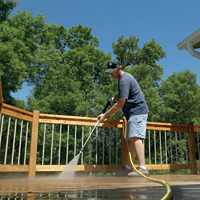How to clean and prepare surfaces before painting
 Surface Preparation
Surface Preparation
To ensure the success of your project, make sure your surface is prepared for the best results. The amount of surface prep required depends on the condition of the area you plan to paint. It is
essential to have a dry, clean surface and to use the correct prep application material. Refer to surface preparation information on the paint container.
- Prepare and clean the surface of all dirt, grease, dust or peeling paint.
- Repair any holes, chips or other surface defects. Sand rough areas smooth.
- For wood surfaces, fill in any cracks or nail holes with filler or wood putty. Note: Filler absorbs stain; putty does not.
- Caulk all open cracks around windows and doors, soffits and fascia.
- Remove lightswitch plates and fixtures that are on the surface to be painted.
- Use a quality primer on all bare wood, and on areas that are stained and will be painted.
Protect Surfaces
Airless sprayers will overspray small amounts of paint. For interior spraying, mask trim, doors and windows, and cover furniture and flooring. For exteriors, remove shutters and cover windows, shrubs and other items you want to protect.
For Interior Spraying
- Always spray in well-ventilated areas.
- Use safety goggles/glasses, mask, and
spray sock.
- Consult your material supplier and operation
manual for specific job requirements.
For Exterior Spraying
- Take note of wind conditions before spraying.
- Use safety goggles/glasses, mask, and
spray sock.
- Consult your material supplier and operation manual for specific job requirements.
- Use a spray shield as necessary.